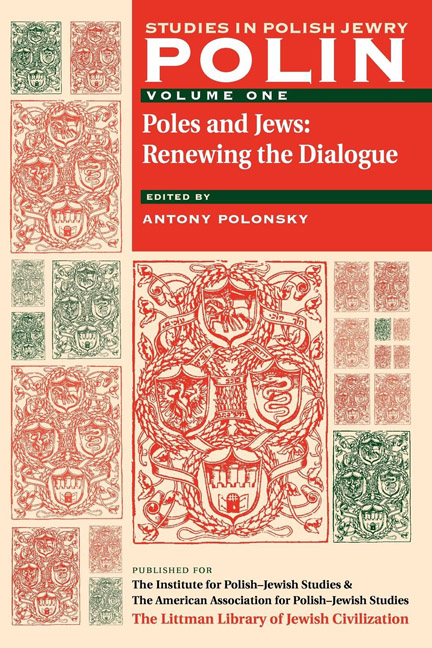Book contents
- Frontmatter
- Dedication
- Editors and Advisers
- Contents
- Polin
- Statement From the Editors
- ARTICLES
- The Reconstruction of Pre-Ashkenazic Jewish Settlements in the Slavic Lands in the Light of Linguistic Sources
- Jewish Perceptions of lnsecurity and Powerlessness in 16th-18th Century Poland
- Some Basic Characteristics of the Jewish Experience in Poland
- The Changes in the Attitude of Polish Society Toward theJews in the 18th Century
- Eros and Enlightenment: Love Against Marriage in the East European Jewish Enlightenment
- Polish-Jewish Relations and the January Uprising: The Polish Perspective
- Loyalty to the Crown or Polish Patriotism? The Metamorphoses of an Anti-Polish Story of the 1863 Insurrection
- The Polish Revolt of 1863 and the Birth of Russification: Bad for the Jews?
- A Turning Point in the History of Polish Socialism and its Attitude Towards the Jewish Question
- The Question of the Assimilation of Jews in the Polish Kingdom (1864-1897): An Interpretive Essay
- The Secular Appropriation of Hasidism by an East European Jewish Intellectual: Dubnow, Renan, and the Besht
- Some Methodological Problems of the Study of Jewish History in Poland Between the Two World Wars
- Jews and Poles in Yiddish Literature in Poland Between the Two World Wars
- Is There a Jewish School of Polish Literature?
- The Underground Movement in Auschwitz Concentration Camp
- DOCUMENTS
- INTERVIEW
- A DIALOGUE
- BIBLIOGRAPHICAL ESSAYS
- BOOK REVIEWS
- CONTRIBUTORS
Some Basic Characteristics of the Jewish Experience in Poland
from ARTICLES
- Frontmatter
- Dedication
- Editors and Advisers
- Contents
- Polin
- Statement From the Editors
- ARTICLES
- The Reconstruction of Pre-Ashkenazic Jewish Settlements in the Slavic Lands in the Light of Linguistic Sources
- Jewish Perceptions of lnsecurity and Powerlessness in 16th-18th Century Poland
- Some Basic Characteristics of the Jewish Experience in Poland
- The Changes in the Attitude of Polish Society Toward theJews in the 18th Century
- Eros and Enlightenment: Love Against Marriage in the East European Jewish Enlightenment
- Polish-Jewish Relations and the January Uprising: The Polish Perspective
- Loyalty to the Crown or Polish Patriotism? The Metamorphoses of an Anti-Polish Story of the 1863 Insurrection
- The Polish Revolt of 1863 and the Birth of Russification: Bad for the Jews?
- A Turning Point in the History of Polish Socialism and its Attitude Towards the Jewish Question
- The Question of the Assimilation of Jews in the Polish Kingdom (1864-1897): An Interpretive Essay
- The Secular Appropriation of Hasidism by an East European Jewish Intellectual: Dubnow, Renan, and the Besht
- Some Methodological Problems of the Study of Jewish History in Poland Between the Two World Wars
- Jews and Poles in Yiddish Literature in Poland Between the Two World Wars
- Is There a Jewish School of Polish Literature?
- The Underground Movement in Auschwitz Concentration Camp
- DOCUMENTS
- INTERVIEW
- A DIALOGUE
- BIBLIOGRAPHICAL ESSAYS
- BOOK REVIEWS
- CONTRIBUTORS
Summary
To speak of basic characteristics is to generalize and to generalize is to endanger the truth. None of the six constructs or schemata which will be suggested here is absolutely true in the sense that one could not prepare lists of exceptions to each, as well as dozens of quibbles and qualifications. This understood, it is proposed that these six constructs are essential filaments in the web of the historical experience of the Jews in the Polish Commonwealth. In other, paradoxical words, it is being asserted here that these are the fictions by which the truth can be discovered.
The first item on the list will be also the most objective. As Professor Salo Baron has taught us, one properly opens the description of a Jewish community with a discussion of numbers. For much of its history the Polish-Jewish community was the largest in the world. Indeed, even today, their descendants include most of the Jews in the Soviet Union and North America and about half of the Jewish population of the State of Israel. Furthermore Polish Jews comprised a very substantial proportion indeed of the population of the Polish Commonwealth as a whole. It may be that during the 18th century nearly a majority of the town-dwellers in Poland Lithuania were Jews. Recent work on the demographic history of Poland, however, has called into question virtually every estimate of the population of historical Poland. Church records of births, baptisms, weddings and deaths, which are the most objective and reliable sources of information, are least useful in computing the Jewish population. Estimates of Jewish numbers have been based mainly on fiscal records, especially the hearth taxes, which are notoriously unreliable. Further, there is no agreement whatsoever as to how many Jews lived in each dwelling. As a result, estimates of the mid-17th century Jewish population, for example, range between 170,000 and 450,000. Virtually all Jewish historians have accepted Raphael Mahler's carefully calculated figure of 750,000 Jews in Poland Lithuania in 1764-5. Recently, however, even Mahler's methods have been called into question. Furthermore, there is a large number of equally important subsidiary questions about demographic history which remain unresolved, most notably the rate of expansion of the Jewish population during different periods.
- Type
- Chapter
- Information
- Poles and Jews: Renewing the Dialogue , pp. 28 - 34Publisher: Liverpool University PressPrint publication year: 2004

